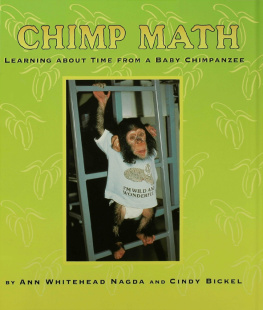Contents
Guide

CHIMP MATH
L EARNING ABOUT T IME FROM A B ABY C HIMPANZEE
BY A NN W HITEHEAD N AGDA
AND C INDY B ICKEL

Henry Holt and Company
New York
The author and publisher have provided this e-book to you for your personal use only. You may not make this e-book publicly available in any way. Copyright infringement is against the law. If you believe the copy of this e-book you are reading infringes on the authors copyright, please notify the publisher at: us.macmillanusa.com/piracy.
To Marilyn Malin, who always believed in my writingA. W. N.
To my mom, who taught me compassion, patience, and TLC
Love youC. B.
Henry Holt and Company, LLC
Publishers since 1866
175 Fifth Avenue
New York, New York 10010
www.HenryHoltKids.com
Henry Holt is a registered trademark of Henry Holt and Company, LLC.
Text and story concept copyright 2002 by Ann Whitehead Nagda
Photographs copyright 2002 by the Denver Zoological Foundation, Inc.
All rights reserved.
Distributed in Canada by H. B. Fenn and Company Ltd.
Photo credits: All Denver Zoological Foundation images by Cindy Bickel with the following exceptionsAnn Rademacher, 2 (bottom), 4; John Edwards, 7, 21, 27 (left), 29, 30 (top left), 31 (top); M. A. Huffman, 8; Denver Zoo archives, 13, 30 (top right).
Wed also like to thank the following for permission to use photographs from their collections:
Sedgwick County Zoo archives, 9; Lyn Alweis/Denver Post, 22.
Library of Congress Cataloging-in-Publication Data
Nagda, Ann Whitehead.
Chimp math : learning about time from a baby chimpanzee / by Ann Whitehead Nagda and Cindy Bickel.
1. Time measurementJuvenile literature. 2. ChimpanzeesJuvenile literature.
[1. Chimpanzees. 2. AnimalsInfancy. 3. Time measurement.] I. Bickel, Cindy. II. Title.
QB209.5.N34 2001 529.7dc21 00-57529
ISBN-13: 978-0-8050-6674-6 / ISBN-10: 0-8050-6674-8
First Edition2002
eISBN 978-1-4668-6655-3
First eBook Edition: March 2014

We are grateful for the cooperation of the Denver Zoo, Denser, Colorado.

D RUMMING IS HARD WORK.

I CAN CRAWL!
Thanks to Lisa Mesple, Roberta Flexer, Candy Hyde, Barb Slenger, and Susannah Richards for helping with the math.

S AY CHEESE!
I NTRODUCTION
Chimpanzees are like people in many ways. They use tools and solve problems. They feel happy and sad and angry. In the wild they sleep when they are tired and eat when they are hungry. Chimps have no use for clocks or calendars. But a zoo keeps time records for a baby chimp to make sure he is eating, learning, and growing properly. This book will use time lines, time charts, clocks, and calendars to help tell the story of Jiggs, a chimpanzee that was raised by people at two different zoos. If you want the story without the time records, you can read only the right-hand pages of the book. To learn more about Jiggs hour by hour and day by day, you can look at the left-hand pages as well.
TIME LINE OF CHIMPANZEES IN THE TWENTIETH CENTURY


A WILD CHIMPANZEE MOTHER AND HER BABY IN AFRICA.
A time line shows what happened during a certain period of time. The time line above shows things that happened to chimpanzees during the twentieth century. A century is 100 years. When you look at this time line, you can see that Jane Goodall, who is famous for her work with chimps, went to Africa in 1960 to learn about chimpanzees in their own habitat.

D R . N ELSON, A PEDIATRICIAN, EXAMINES THE NEWBORN CHIMPANZEE.
L ate one night, a chimpanzee named Holly gave birth to a small, scrawny baby. The staff at the Sedgwick County Zoo in Wichita, Kansas, thought the new baby seemed very weak. They hoped that Holly would pick him up and care for him, but she ignored her baby. Finally, fearing for the tiny chimps life, they removed him from his mother and placed him in an incubator, which kept him warm and safe.
TIME LINE OF A DAY

The time line on this page is for a much shorter period of time than the one . This one shows all the times that the baby chimpanzee was fed in one day. A day is 24 hours long.
The chimp was fed every two hours. The first feeding was at midnight. The second feeding was at 2:00 A.M . The letters A.M. stand for ante meridiem, which means before noon. The letters P.M. stand for post meridiem, which means after noon.

J IGGS, THE BABY CHIMPANZEE.
Dr. R. A. Jiggs Nelson, a doctor for human babies, was called in to help care for the fragile baby chimpanzee. The infant was too weak to nurse at first, so Dr. Nelson decided to feed him through a tube. After five days, the baby chimp was stronger and could drink from a bottle. He was fed two ounces of milk every two hours. He was named Jiggs, in honor of the doctor who took such good care of him.
HOW JIGGS GREW WEEK BY WEEK

A graph is another way to show whats happened over a period of time. This bar graph shows how the baby chimpanzees weight changed during the weeks he was at the Sedgwick County Zoo. A week is seven days long. This graph shows what the baby chimp weighed every week.
Jiggs weighed two pounds twelve ounces when he was born, but he lost weight during his first week. The graph shows that he weighed two and a half pounds at one week of age. There are sixteen ounces in one pound, so two and a half pounds is the same as two pounds eight ounces. By the time he was seventeen weeks old, he weighed six pounds thirteen ounces. He had gained four pounds one ounce since birth.


























